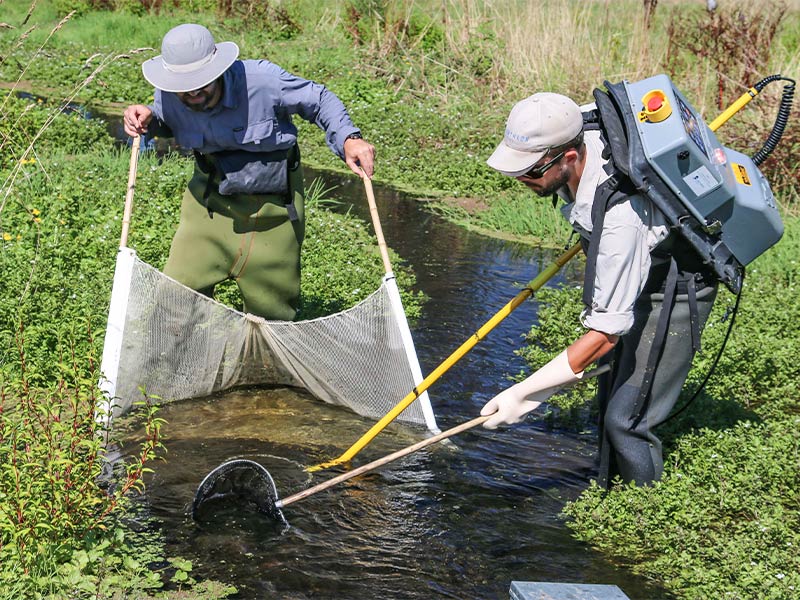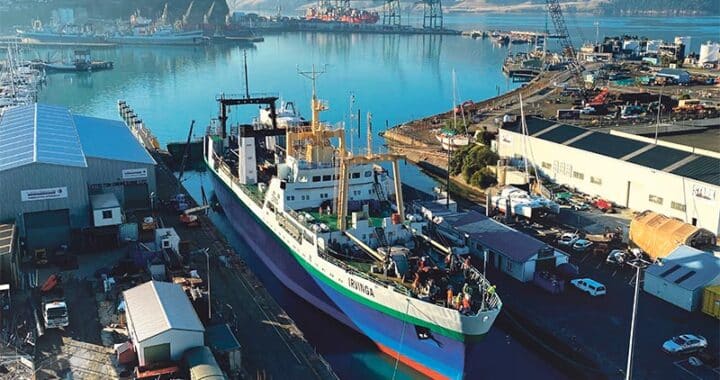Electric fishing programme reveals insights on native fish populations
3 min read
Fish & Game staff sampling a Wairarapa spring creek as part of their stream health monitoring programme. Photo: Supplied
The effects of barriers to fish passage on native species and trout in Taranaki, and a recovering kōaro and eel population in Nelson/Marlborough are among the insights gained in an electric fishing research programme carried out by Fish & Game.
The programme involves teams using a pole that emits a low-voltage, high-current charge to sweep rivers and streams in various regions, including Otago, Central South Island, West Coast, North Canterbury, Nelson Marlborough, Wellington, and Taranaki.
Fish drawn towards the charge are temporarily stunned and scooped up in a net. They are identified, weighed, and measured before being returned to the water.
The programme is aimed at monitoring trout and salmon populations and recording various native freshwater fish species such as galaxiids, kōaro, kokopu, bullies, eels, torrent fish, lamprey, and koura. Fish & Game also note waterway conditions, macroinvertebrates, and barriers to fish movement.
Data collected from the programme is entered into NIWA’s New Zealand Freshwater Fish Database for use by other freshwater scientists and to inform both regional and national policy.
The electric fishing survey in Taranaki highlighted a decline in water and habitat quality that occurs down the length of ringplain catchment. In Nelson and Marlborough, staff are tracking the recovery of kōaro and eel population after native fisheries were destroyed by Cyclone Gita in 2018.
Staff in the region have also found increased climate-change-generated floods pose as much, if not more, risk to native fish populations as they do to trout.
“Electric fishing is helping to protect New Zealand’s freshwater fish and rivers,” said Corina Jordan, chief executive of Fish & Game.
“It may sound unusual but it’s an effective way to keep watch on the state of our fish species, including indigenous populations, and the places they live.
“These surveys support other research that show native fish populations, as with juvenile trout, are at risk from the increased frequency and size of flooding.

In Hawke’s Bay, Fish & Game staff plan to partner with other local agencies and iwi to resume electric fishing in small streams before Cyclone Gabrielle brought the monitoring programme to a halt.
Before Gabrielle swept in, Fish & Game in Nelson and Marlborough region was already tracking the recovery of native fish populations affected Cyclone Gita in 2018.
Under the Resource Management Act, the management of physical resources must have regard to the protection of the habitat of trout and salmon, said Fish & Game.
Fish & Game primarily uses electric fishing to confirm the presence of juvenile trout, a marker of successful spawning.
“Because juvenile trout stay within the stream their parents spawned in, any observation proves that trout spawning occurred somewhere within the reach or further upriver,” Jordan said.
“The presence of trout means Fish & Game can advocate for that habitat, which benefits all aquatic life ─ native and valued introduced species.”
Electric fishing is also used to educate school and catchment groups about stream habitat and health.
Fish & Game also shares data with agencies such as the Department of Conservation for resource consent and partners with universities on electric fishing monitoring projects.
“As river guardians, Fish & Game has been gathering and sharing data for more than 30 years and will continue monitoring in future for the benefit of all freshwater fish species,” Jordan said.



